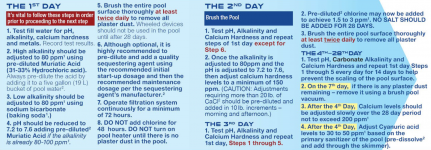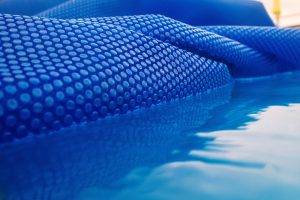The pool was replastered 6 days ago.
The calcium is low.
As per the bicarbonate startup method (though the installers didn't do the bicarbonate, have been raising the bicarbonate, with a goal of 150 -200 for the first month.
yesterday I added bicarbonate and calcium, only about 2 hours apart
The pool has pine needles that blow into it, some settle on the floor.
This morning when I brushed, the pine needles seemed to be cemented to the floor, they didn't brush off.
any advice? ( gently use a steel brush, which I've avoided up until now?)
Also with chemistry, there continues to be dust.
Yesterday, the chemistry analysis from the pool store was a little off, so that motivated the adjustment
it was pH 7.0 (after lowering the amount the pool store suggested, which seems a bit odd). this morning seems about 7.2
Alkalinity 100
Calcium H 100
no chlorine,
cyanuric acid 10 (non added)
26000 gallons
I added alkalinity to raise it to 125 last night
I added calcium , still working on this, should be about 150 though a bit hard to get an accurate reading. trying to get it above 200.
Added some cyanuric acid, it doesn't dissolve quickly, so did about 1/3 of what was needed to get above 30 ppm
Chlorine: 6 tabs, added 2/3 gal shock which brought it up .
Am thinking the calcium cemented the pine needles and I should scrape them out.
General Advice? Not positive giving higher alkalinity (sodium bicarbonate) should be done, but it seems like that preserves the plaster better while it cures. The plasterer was less than optimum instruction wise.
The calcium is low.
As per the bicarbonate startup method (though the installers didn't do the bicarbonate, have been raising the bicarbonate, with a goal of 150 -200 for the first month.
yesterday I added bicarbonate and calcium, only about 2 hours apart
The pool has pine needles that blow into it, some settle on the floor.
This morning when I brushed, the pine needles seemed to be cemented to the floor, they didn't brush off.
any advice? ( gently use a steel brush, which I've avoided up until now?)
Also with chemistry, there continues to be dust.
Yesterday, the chemistry analysis from the pool store was a little off, so that motivated the adjustment
it was pH 7.0 (after lowering the amount the pool store suggested, which seems a bit odd). this morning seems about 7.2
Alkalinity 100
Calcium H 100
no chlorine,
cyanuric acid 10 (non added)
26000 gallons
I added alkalinity to raise it to 125 last night
I added calcium , still working on this, should be about 150 though a bit hard to get an accurate reading. trying to get it above 200.
Added some cyanuric acid, it doesn't dissolve quickly, so did about 1/3 of what was needed to get above 30 ppm
Chlorine: 6 tabs, added 2/3 gal shock which brought it up .
Am thinking the calcium cemented the pine needles and I should scrape them out.
General Advice? Not positive giving higher alkalinity (sodium bicarbonate) should be done, but it seems like that preserves the plaster better while it cures. The plasterer was less than optimum instruction wise.



